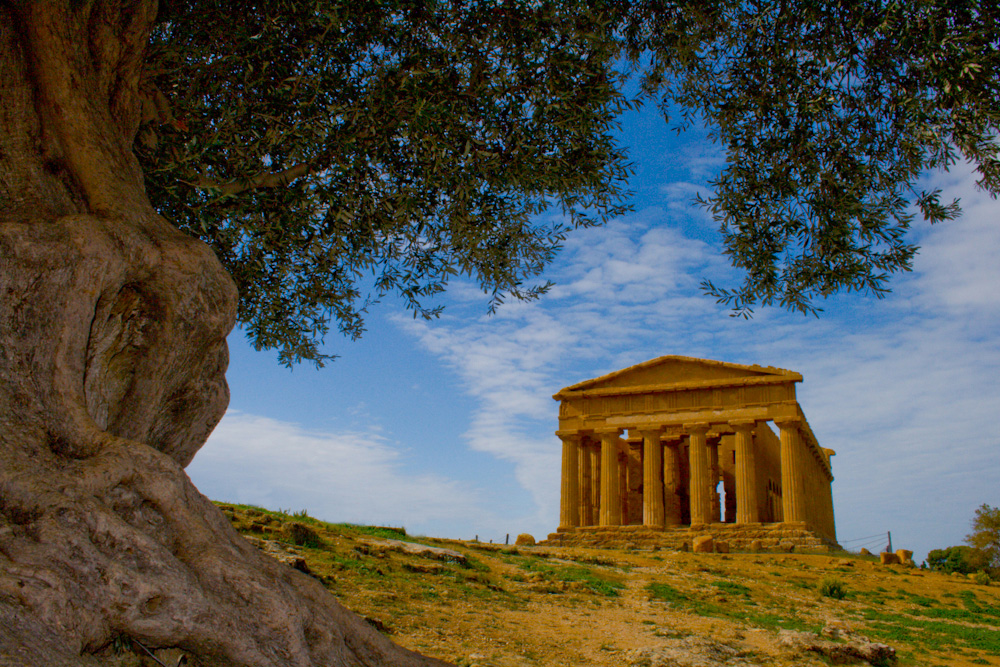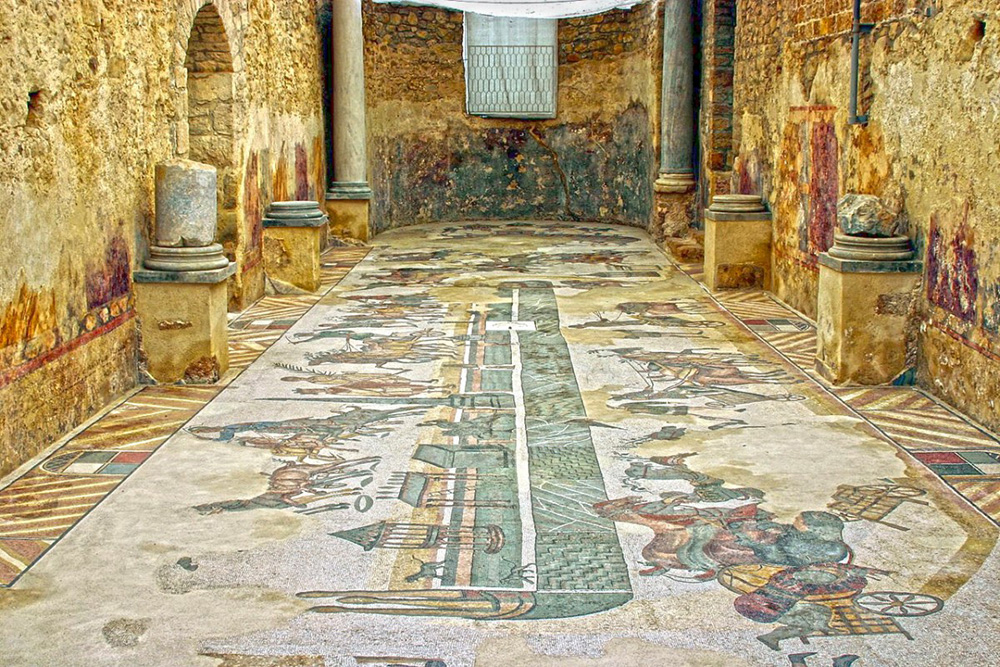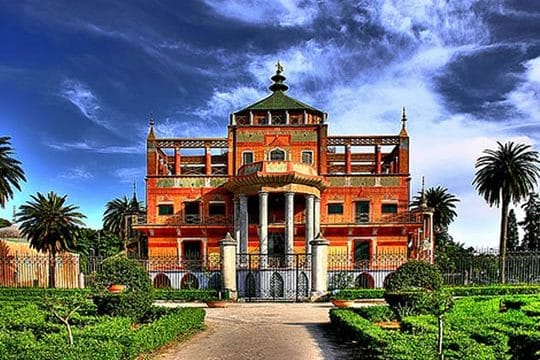Because of its geographical location, at the center of the Mediterranean Sea on which three continents, Europe, Asia and Africa, over the centuries, Sicily has been the meeting point and clash of the most diverse civilizations in ancient, medieval and modern history.
Throughout its history, Sicily, (situated poised between Europe, Asia and Africa) has been both the meeting point and the battlefield of different civilizations.

First inhabitants
The first known inhabitants of the island were the Sicanians, originally an Iberian tribe, hence the ancient name of Sicania, for the island, and the Sicels, who crossed over from Italy, pushed the Sicanians inland and settled in the eastern part of the island. The western region was occupied by the Elymians, a people thought to descend from Trojan refugees fleeing from their burning town of Troy.
According to Virgil’s Aeneid, some of them refused to follow Aeneas up to Latium and decided to remain in Sicily. By the 12th century BC the Phoenicians had established trading outposts along the western coasts of Sicily and later founded the towns of Mozia, Palermo and Solunto. As Carthage grew in power these settlements came under its direct control.
Greeks
From the 8th century BC the Greeks began to move in, and within 100 years had built some of the most important towns on the island: Siracusa, Catania, Messina, Lentini, Gela, Agrigento, Selinunte. In the 5th century BC. Under the rule of the tyrants, Syracuse gained hegemony over most of Magna Grecia, (the colonies along the coast of southern Italy) and came to rival Athens as the most populous Greek city in the world, unrivalled for its wealth splendour.
Romans
In 241 BC, Sicily was a battleground in the epic struggle between the ascending power of Rome and Carthage, the dominant sea power in the Western Mediterranean. By the end of the first Punic War the Carthaginians were driven out and all of Sicily (except for Siracusa) fell into Roman hands, becoming Rome’s first province outside the Italian peninsula. In 211 BC, during the Second Punic War, after strenuously resisting a two-year siege, thanks to the genius of Archimedes, mathematician, physicist, engineer, inventor and astronomer, one of the greatest scientists in history – Siracusa fell and Sicily was unified under Roman rule. Busy conquering the world and in need of grain to feed the army, the Romans began to cut down many of the forests which in ancient times covered the most of the island, and instead planted corn making Sicily the Granary of Rome. Romans’ respect for Greek Culture and admiration for Greek Art began in Sicily.
The island became a place for vacation and relaxation and was visited by many great figures in the history of Rome: Emperor Hadrian climbed to the top of Mount Etna and built an altar there; Marcus Aurelius visited the isle and wealthy Roman senators owned sumptuous villas. Imposing monuments and remains of the classical age in Sicily include some of the best preserved Doric temples to be found anywhere (in Agrigento, Selinunte, Siracusa, Segesta), the ancient theatres in Siracusa, Taormina, Tindari and Segesta, the Roman amphitheatres in Siracusa, Catania, andTermini imerese, the Roman Basilica in Tindari, the Roman Villas in Patti, Palermo,Noto and the luxurious Villa del Casale at Piazza Armerina covered with 3500 sqm of floor mosaics, unquestionably one of the most important Roman building complexes to have been discovered in modern times.

Byzantines
In the 3rd century AD the decline of the later Roman Empire allowed first the Vandals and then the Ostrogoths to gain military control of Sicily. However in AD 535 it was recaptured for the Byzantines by the Eastern Emperor Justinian, whose aim was to revive the glory of Roman Empire by regaining the lost provinces of the West. For 5 years Siracusa was the capital of the Empire, when Emperor Constans II decided to move from Constantinople to Sicily in 665.
Arabs
The culture of the island was mainly Greek until a new dynamic force appeared in the Mediterranean world: the Arabs. After several unsuccessful attemps, in 827 they finally invaded Sicily and after 50 years of furious fighting imposed their rule over all the island. Sicily became the “Heaven of the Mediterranean”. The main towns acquired the distinctive character of eastern Mediterranean cities, crowded, noisy and bustling with trade and commerce; Palermo, became the capital of the island and one of the most important towns of the Islamic world, second only to Baghdad, legendary for its luxurious gardens and buildings. The countryside, scientifically cultivated and irrigated, became very fertile and Sicily became an early entrepot for vegetables and fruits never before grown in Europe: oranges, lemons, mulberry trees, pistachio, cotton, sugar cane. While Europe was falling into the Dark Ages, sciences and the arts flourished in Sicily.
Normans
After a reign of 200 years the Arabs were ruined by division and finally displaced by the Norman conquest of Sicily (1060–91). Roger II was crowned in oriental splendour at Palermo thus becoming the first king of Sicily. The merging of Arab civilisation and the Norman world created a kind of miracle, a cultural phenomenon which for centuries allowed Sicily to outshine every other region in Europe. The Normans created in Sicily one of the wealthiest and most prosperous state of all European states, a cosmopolitan, multi-ethnic and multi-cultural society showing, in times when intolerance was the rule, that the peaceful coexistence of different religions and cultures is possible.
The greatest legacies of the blend of Arab, Greek, Roman and Norman craftsmanship are the impressive Cathedrals of Cefalù, Monreale, which, with their dazzling gilded byzantine mosaics, represent one of the architectural wonders of the Middle Ages, as well as Palermo Cathedral and the Palace of the Normans in Palermo, once the Palace of the Arab Emirs built on Punic and Roman remains and considerably enlarged by the Normans in the 12th century when for a while it became the most important and intellectually vibrant court in Europe. The Palatine Chapel, built in the centre of the palace, has a wooden celing with the only monumental-scale pictorial cycle from the Fatimid period in the Mediterranean basin to have survived in its entirety. There are also the Church of the Martorana, famous for its superb Byzantine mosaics, and the arab-style Sollazzi (palaces of rest and delight) in Palermo known as the Castles of Zisa, Maredolce and Cuba.
Swabians and Angevins
When the last Norman King, William II, died childless in 1189, the Norman throne was inherited by his aunt, Constance, who some years earlier had been married off to the Holy Roman Emperor Henry VI of Hohenstaufen, meaning that the crown was now legitimately transferred to him. This union saw the birth of Frederick II, King of Sicily and later Holy Roman Emperor, one of the most extraordinary men of the Middle Ages, known in his own time as Stupor Mundi, the Wonder of the World. Frederick, brought up at the Royal Palace in Palermo, regarded Sicily as his home and his ideal country. When on a crusade in Jerusalem he remarked that “God would not have chosen Palestine if he had seen my Kingdom of Sicily”. To a contemporary chronicler Sicily was “ a pleasure garden admist a waste of thorns to which he turned full of longing when he sailed to and fro upon the empire’s seas”.
Frederick benevolent despotism promised a return to the Golden Age of Roger II. To administer his southern realm justly, Frederick promulgated the Constitutions of Melfi, which laid the foundation of the lay state for the first time, and for which today he is still considered, one of the greatest statesmen of all time. Frederick II also encouraged the formation of the Sicilian School of Poetry, the first school of courtly love poetry in Italy, which made a fundamental contribution to the development of the new Italian language. The Hohenstaufens were primarily interested in fortifications and military buildings and left several castles in Sicily, among them Castello Maniace in Siracusa, Castello Ursino in Catania, the Castle of Augusta, Lombardy Castle and Frederick’s Tower at Enna. Hohenstaufen rule did not long survive Frederick’s death in 1250.
Aragonese e Spaniards
Frederick’s reign was followed by 15 years of civil war in which rival claimants struggled for the kingdom. In the end, with papal support the French Angevins seized control of the kingdom. But the new regime’s religious and racial intolerance combined with heavy taxation and the depredations inflicted by the foreign troops, provoked the hatred of the Sicilians, who, in 1282 revolted against the oppressive rule. The uprising known as the Sicilian Vespers forced the French to leave the island which became independent and chose as king Peter III of Aragon, who was connected by marriage with the house of Hohenstaufen. In 1296 the island was separated from Aragon and gained independence under the rule of Frederick III with the creation of the Kingdom of Trinacria.
In 1392 a Spanish invasion brought Sicily under direct Spanish control. Henceforward the king would be a permanent absentee, and for some 300 years the island was ruled through foreign Viceroys. This policy remained the cornerstone for the conduct of almost every Viceroy until Spanish possession of the island ended. In 1713 the Treaty of Utrecht, which put an end to the war of Spanish Succession, assigned Sicily to Savoy, which in 1720 exchanged it with Emperor Charles VI of Austria for Sardinia. The legacy of the long and controversial Spanish period is the sumptuous Baroque of countless luminous churches, palaces and civic buildings, all built from the same warm, honey-coloured local stone, and of entire towns in the Val di Noto (the southeast corner of Sicily) including Modica, Ragusa Ibla, Noto, Scicli.

Bourbons
In 1734 the Spanish Bourbon Don Carlos, later Charles III of Spain acquired Sicily from Austria and became King of Naples and Sicily. The Bourbons, who actually ruled from Naples, brought initially a degree of autonomy to Sicily and also to Naples, which had likewise been ruled from afar for some time. The Bourbon kings resided at Naples, except in 1799 and from 1806 to 1815, when Naples was held by the French. The centralizing policies of the Bourbons were resisted by the Sicilian nobles, who welcomed British intervention (1811–14).
Feudal privileges were renounced in 1812 but in practice continued much longer. Naples and Sicily were merged, despite Sicilian protests, in 1816, when King Ferdinand IV styled himself officially King of the Two Sicilies. Revolts occurred in 1820 and 1848–49 and were mercilessly suppressed. Of the Bourbon period there are the Chinese Palace in Palermo, symbol of the oriental taste of the end of 18th century, and the Royal Hunting Lodge at Ficuzza, places of delight of the King Ferdinand and Queen Marie Caroline who were forced into Sicilian exile during the Neapolitan Republican revolution.
Sicily today
Sicily remained under the Bourbon dynasty until 1860, when Giuseppe Garibaldi landed on the island with his famous army of 1000 red-shirted volunteers. After the rapid success of Garibaldi’s campaign, Sicily joined the new kingdom of Italy. Today the island is part of the Republic of Italy, and since 1946 has been an autonomous region with its own Parliament and extensive powers of self-government.